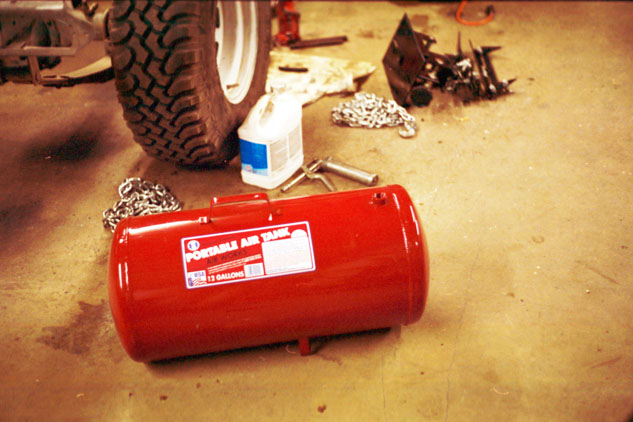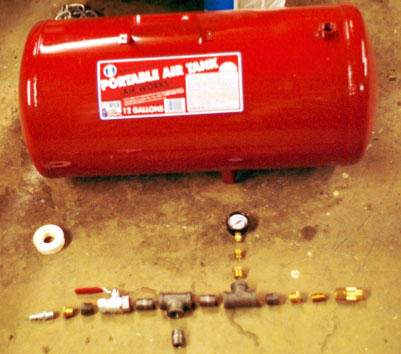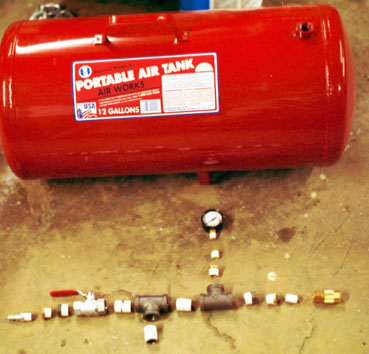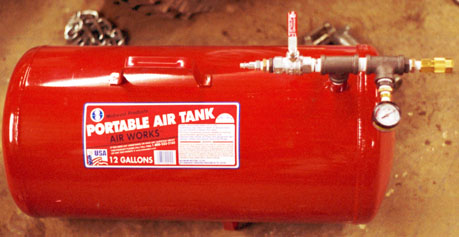
One of the things about using high consumption air tools is that it seems you can never get enough clean, dry air where and when you need it. On my sanding and sand blasting page, I talk about how I wished I had rewired my garage for 220 so I could have gotten a bigger air compressor. Sanding, using the air die grinder, high speed cut off wheel, and especially sand blasting had me wishing for more air.
Well, short of rewiring and getting a bigger compressor, I thought of an idea that turned out to be very inexpensive but very effective. An auxiliary air tank or reservoir, right at the point of use helps in a number of ways. The most obvious, is by having additional air storage capacity, more air can be used before the pressure drops to where the compressor has to kick in. Of course, in continuous duty applications, once you've used this reserve air, you can't get any more air than the compressor can deliver, so it is of little help there. But once pressure is built up, you can run longer before the pressure drops to where there isn't enough to run the tool. Also, you have to wait longer for the compressor to fill up it's own tank plus the aux tank.
But there are a couple of other advantages. One is that with a long hose from the compressor to the point of use, the aux tank gives more pressure for a given flow rate because the air isn't flowing through as much restrictive hose, filters, dryers and fittings. This helps the tool work better, with a more even pressure feeding it.
The second advantage is less obvious. Even with a dryer in line, after a while you still get condensation in the lines which is especially bothersome when sand blasting, as the water tends to clog up the tip. The aux tank acts as a huge condenser. The air enters it and the walls of the tank act as a large heat sink and cool the air, allowing the moisture to condense out and fall to the bottom of the tank before spraying out the tip of your tool.
Last, and this is what these tanks were intended for, you have a portable source of compressed air. There's a lot of times I use this tank for working out in the driveway, where it is easier to simply carry the tank out there than to untangle and drag a long hose out from the garage. Use it to inflate tires, run low consumption air tools like air impact, or blow parts clean.
As purchased, the 12 gallon tank wasn't suited for what I needed. It would add another third of capacity to the 33 gallon tank on my compressor, but it was intended to be filled with a small schrader valve like the kind on your tire stems, way too small. And it was intended to have a tire chuck type hose always attached. To make it more versatile for connecting to my compressed air system, I went to the hardware store and got a handful of various fittings and a ball valve and plumbed it up. Kind of a Rube Goldberg type thing, I needed a number of reducers and nipples and such to get everything fitted together.
The inlet is a standard male quick connect. You hook your source of air from your compressor hose to this to fill the tank. Next is a ball valve. Leave the ball valve open when you are using the tank as a remote reservoir/dryer when it is connected to the compressor. Close the valve when you want to take the tank outside and use it as a portable.
Then a T-fitting goes on the port on the top of the tank. The inlet goes to the male quick connect I mentioned above. The outlet goes to another T-fitting for the pressure gauge which came with the tank. This lets you monitor the fill condition of the tank. Last, a self-closing female disconnect goes on the outlet. Plug your short coiled hose on here for your air tool or sand blaster.



